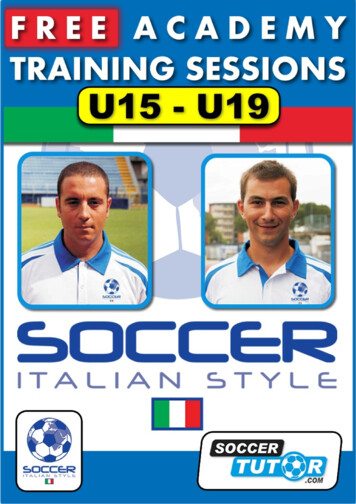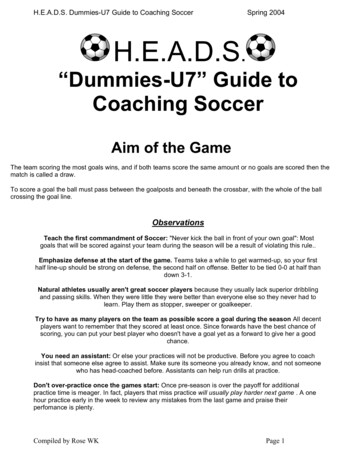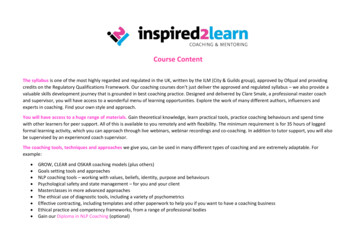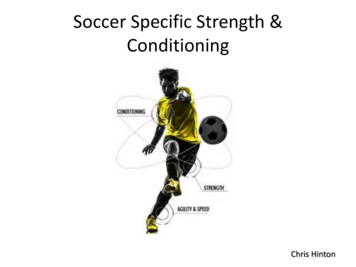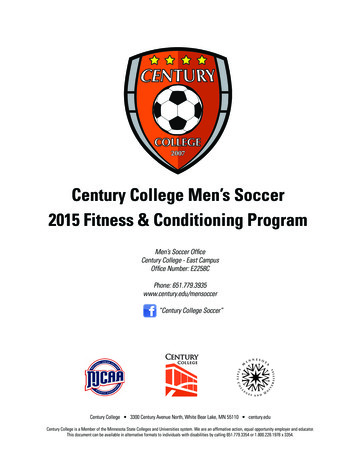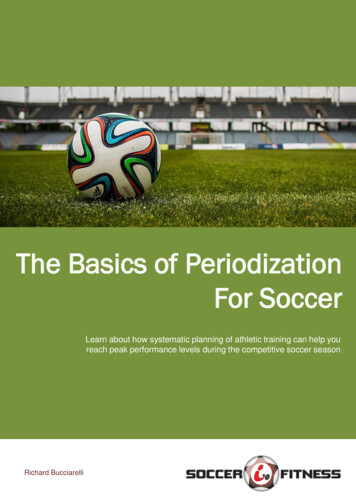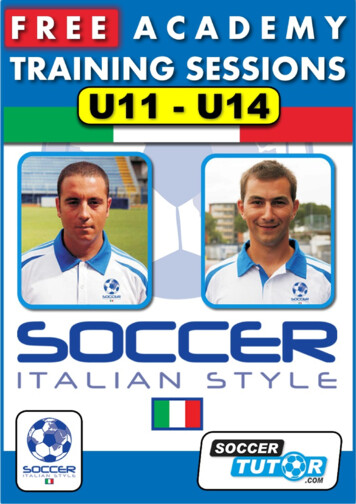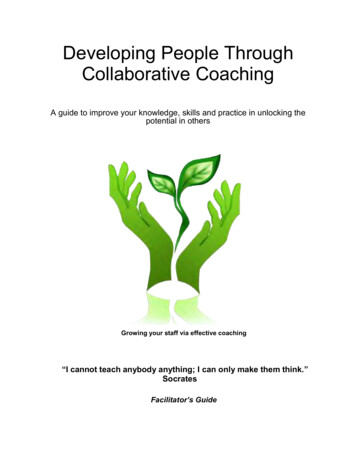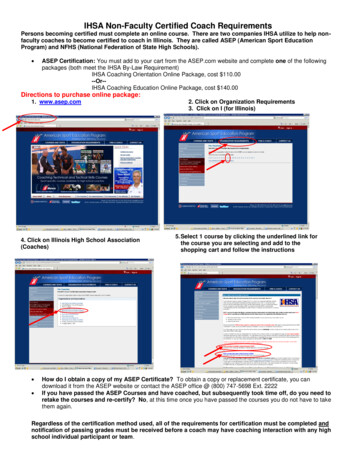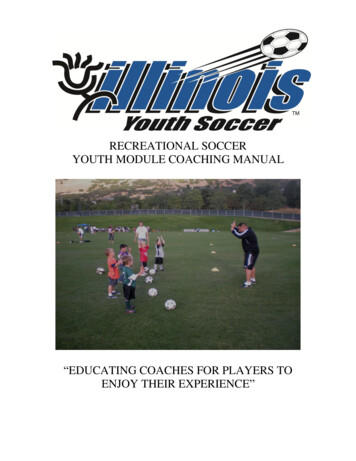
Transcription
RECREATIONAL SOCCERYOUTH MODULE COACHING MANUAL“EDUCATING COACHES FOR PLAYERS TOENJOY THEIR EXPERIENCE”
Coach,On behalf of the players you will be coaching and teaching, I would like to thank you fortaking the time to attend this coaching course. I realize that as a coach and teacher, youare the catalyst and a role model who can make a difference in the lives of our children.All coaches who teach this course are certified USSF coaches and have attended theNational Youth License course that is given by US Youth Soccer and part of US Soccer.These Youth-oriented individuals will utilize the most up to date educational ageappropriate activities in transferring their extensive practical coaching and playingexperiences to you. Not only do these individuals understand the game but also the spiritof the game.Our objectives of the course are: To give a better understanding of youth players To give you a teaching and coaching framework To provide you with an opportunity to reflect upon what you already know aboutteaching and coaching To provide you with the techniques to help you develop your players to theirmaximum potentialWe combine classroom discussions with field participation to maximize yourunderstanding of the material. We encourage you to ask questions at any time during thecourse. I highly recommend you take notes for future reference because of the vastamount of new information that will be presented. You are invited to take part in thepractical field sessions as this will give you a better understanding of the activities andthe method.We admire your commitment to our children and your desires to self improve for thebenefit of the players and their experience. It is people like you who make a positivedifference in our children’s lives.Teaching through Enthusiasm,Rick FloresDirector of Coaching
ILLINOIS YOUTH SOCCER ASSOCIATION(State Coaching Education Flow Chart)RECREATIONCOMPETITIVEOTHERYOUTHMODULEU6/U8E COURSEGK COURSEYOUTHMODULEU10/U12D ICENSEAC LICENSEB LICENSEA LICENSEUSSF GKCOURSE
YOUTH COACHINGMANUAL
Youth ModuleTable of ContentsState Education Flow Chart and Certification BreakdownWhat is Recreational Soccer?Characteristics of U6 ChildrenCharacteristics of U8 ChildrenCharacteristics of U10 ChildrenCharacteristics of U12 ChildrenImplications for Coaching SoccerThe Three areas of a Practice SessionTeam AdministrationTeam OrganizationCare and PreventionRisk ManagementGuided DiscoveryModified Rules Recommendation Ages U6/U8/U10/U12Age Appropriate Activities
What is Recreational Soccer?Recreational soccer is a soccer program primarily devoted to the enjoyment anddevelopment of soccer players without the emphasis on travel or high-level competition.The purpose of recreational soccer is to provide an opportunity for the participants tohave fun, learn the sport and develop life skills including a lifelong love of the game.Therefore: Access is open to all who desire to participate (The Game for ALL Kids). Emphasis is on active participation (minimum of half game playing time). Objective is for the players to enjoy the experience. Success and excellence are measured in players attracted and players retained. Recreational soccer is all about fun, recreation, love of the game, and winning isnot a measure of success.Model Emphasis Excellence Body Decisions OpponentsSome of the main characteristics of recreational play and recreational playersare as follows: Almost every player and parent will start out in recreational soccer. Two-year age groups are typical of recreational teams so there is a wide rangebetween the most skilled player and the least skilled player. Wider age gaps create greater differences in physical, mental and socialdevelopment. Players new to the sport are constantly being introduced into the mix. Soccer, for the child who wants to play, is an outlet for energy and enthusiasm. For others it is an imposed activity, something selected for the child by the parent. Fit and unfit players play together. Participation stretches from always there to when it is convenient. Parents often sign up a player for the next season without the child being involvedin the process. Recreational players generally do not develop strong feelings against the opposingteam because they often have friends on the opposing team. The game is played for enjoyment and not necessarily future playingopportunities on college or elite teams, however, at the younger age groups arewhere elite players first begin to develop. Many young children start out in soccer. (It has been said that, “Soccer is the firstsport that American children play.”) Soccer is a game, especially at the veryyoung level, where all skill-levels of children can participate and have fun. Many young children try out many sports at a young age and may jump from oneactivity to another during the year or even during the same season.Some of the main characteristics of recreational coaches are as follows: Virtually every recreational coach will be an unpaid parent volunteer. Many recreational coaches are coaching their own children. Many times thesechildren are “would-be stars” in the eyes of their parents. Equal treatment may nothappen as a result. About half of youth sport coaches will drop out of coaching within the first year. Most of the youngest age-group coaches are first-time coaches with little or nosoccer experience and no coaching experience.
CHARACHTERISTICS OF U6 CHILDRENPsychomotor Development(Of or relating to movement or muscular activity associated with mental processes)ooooooooooooMovement education approachDifference between boys and girls is minimalWeight range approx 30-50 lbs.Height Range approx 35-45” for boys and 37-45” for girls.Progress in motor development starts with the head and moves downward to thefeet and fro the center of the body outward.Body segments grow at different rates.Easy fatigue, rapid recovery, heart rate around 90 bpm for boys and girls.Emphasis on fundamental movement skills.Locomotor – walking, running, leaping, jumping, and hopping.Nonlocomotor – bending, stretching, twisting, pulling, pushing, and reaching.Increased use of body parts.Need to explore qualities of rolling and bouncing ball.Cognitive Development(The process of acquiring intelligence and increasingly advanced thought and problemsolving ability from infancy to adulthood)oooooPreoperational stage of cognitive developmentPlay consists of a high degree of imagination and pretend activitiesBeginning to use symbols to represent objects in environment.Tend to only one task at a time in problem solving situations.Process small bits of information at a time, long sequential instructions are notprocessed.o Simple rules only.o Limited understanding of time, space relations, and boundaries.Psychosocial Development(Of or pertaining to the interaction between social and psychological factors.)o Beginning to develop self-concept, body awareness, and self-image throughmovement.o Egocentric – see the world only from their perspective, demonstrated throughparallel play. They all want the ball – their ball!o Need generous praise and the opportunity to play without pressure.o Influential person in their life is most likely their mother or significant parent.o May verbalize team, but does not understand group or collective play.* Characteristics were taken from the US Youth Soccer National Youth License.
CHARACHTERISTICS OF U8 CHILDRENPsychomotor Development(Of or relating to movement or muscular activity associated with mental processes)o Skeletal system is still growing; growth plates are near joints, thus injuries tothose areas merit special considerationo Cardiovascular system is less efficient then an adult’s, a child’s heart rate peakssooner and takes longer to recover to full resting rate.o Temperature regulation system is less efficient then adultso Children elevate their core body temperature more quickly with activity and takelonger to cool down then adults.o There is perceivable improvement in pace and coordination from U6 to U8however the immaturity of a U8 physical ability is obvious.Cognitive Development(The process of acquiring intelligence and increasingly advanced thought and problemsolving ability from infancy to adulthood)o Concrete operational state of cognitive development.o Limited ability to attend to more than one task at a time; the simple task ofcontrolling the ball demands most of the attention capacity, thereby leaving littleor no capacity for making additional decisions.o Concept of time and space relationship is just beginning to develop and will belimited by capacity to attend to multiple tasks.o Limited experience with personal evaluations; effort synonymous withperformance, “if I try hard, then I performed well” regardless of actualperformance.o Beginning to categorize information; some relationships that “do” existPsychosocial Development(Of or pertaining to the interaction between social and psychological factors.)o Self-concept and body image are beginning to develop; very fragile.o Great need for approval from adults such as parents, teachers and coaches. Theylike to show individual skills.o Easily bruised psychologically by both peers and adults; negative comments willcarry great weight.o Like to play soccer because it is “fun”; intrinsically motivated.o Their universe is expanding from home to the neighborhood.o True playmates emerge with the inclination toward partner activities.o Team identity is limited; “I play on coach Bob’s team” or “I play on the Tigers”o There is a desire for social acceptance; they want everyone to like themo The influential person is most likely their father or significant parent.* Characteristics were taken from the US Youth Soccer National Youth License.
CHARACHTERISTICS OF U10 CHILDRENPsychomotor DevelopmentooooGross and small motor skills become more definedBoys and girls begin to develop separatelyAbility to stay on task is lengthenedGreater diversity in playing ability and physical maturity, physically matureindividuals demonstrate stronger motor skillso More prone then adults to heat injuryo Accelerated heat loss, increases risk of hypothermiaCognitive Developmento Some children begin moving from concrete operational to forming operationalstageo Lengthened attention span, ability to sequence thought and actionso Pace factor becoming developed (starting to think ahead)o More inclined towards wanting to play rather than being told to playo Demonstrate increased self-responsibility (i.e. bring ball, water, tuck in jersey,pull up socks)o Starting to recognize fundamental tactical concepts, such as changing directionsof ball, but not always sure whyo Repetitive technique very important, but it must be dynamic and not staticPsychosocial Developmento Beginning to develop self-concept, body awareness, and self-image throughmovement.o Egocentric – see the world only from their perspective, demonstrated throughparallel play. They all want the ball – their ball!o Need generous praise and the opportunity to play without pressure.o Influential person in their life is most likely their mother or significant parent.o May verbalize team, but does not understand group or collective play.* Characteristics were taken from the US Youth Soccer National Youth License.
CHARACHTERISTICS OF U12 CHILDRENPsychomotor Developmento The average age for the beginning of pubescence in girls is 10 years with a rangeof 7-14, for boys is age 12 with a range of 9-16o Strength building activities require overloading the muscles to a greater extentthan endurance activitieso Flexibility training is key to prevention of injuryo Overuse injuries, burnout and high attrition rates associated with high-intensitychildren’s program that fail to stresso Development and learning enjoymento Begin to develop abilities to sustain complex coordinated skill sequencesCognitive Developmento Formal operational stage of cognitive developmento Changes in thought process are the result in an increased ability to acquire andapply knowledgeo Begins to think in abstract terms and can address hypothetical situationso A systematic approach to problem solving appears at this stage, the game ofsoccer must present the ability to thinko Creativity and solve problems while movingPsychosocial DevelopmentooooMore TV, less structured playBeginning to spend more time with friends and less with parentsPopularity influences self-esteemWhether a child enters puberty early or late has important psychologicalimplicationso Learning an appropriate sex roleo Children are susceptible to conform to peer pressureo Most children seek peers that are most like them in age, race, sex and socioeconomic status, opportunity to introduce the value of cultural diversity* Characteristics were taken from the US Youth Soccer National Youth License.
IMPLICATIONS FOR COACHING SOCCERTime of Training Sessions and Number per work week (U6) 45 Minutes 1 day per week with one game on weekend (U8) 1 Hour 1 to 2 days per week with one game on weekend (U10) 1 Hour 15 to 1 Hour 30 min 1 - 2 days per week and one game*Note that these are organized training and games; players must be encouraged to domuch more on their own with a ball.Activities in a Training Session U6 Many of short duration, mostly individual type games. U8 Many of short duration using groups of two. U10 Fewer activities, longer periods.*Types of activities must emphasize individual Technical DevelopmentNature of Training Session UpbeatEncouragingStimulatingMany short water breaksVery little explanationShort demonstrationLots of player participationEvery player has a ballSome Suggested Absolutes Try to have funTraining sessions, though fun in nature, must have a defined objectivePlayer mistakes are an expected circumstance of our gameNone of these are appropriate: criticism, threats, blame, yelling, humiliating,ridiculing, and/or showing biases Above all leave the “winning at all cost” notion in the trashAn Approach to the game for a U6 through U8 players Coaches are role modelsA Coach is one of the four most important influences in a child’s lifePlayers are affected by a coach’s behavior on the sidelinesChildren play soccer because they want to kick the ballShort verbal blips followed by a chance to move around and touch the ball willget great results Try to let the players have fun and you’ll keep your sanity
Some Recommended Solutions A key to being a successful youth soccer coach (does not mean winning) is todraw upon your life experiences If you grew up playing sports of any kind, you possess some knowledge of goodand bad coaching technique Don’t place yourself above the boys and girls Be organized, but not rigid, that could lead to boredomThings a coach should knowDon’t Become frustrated Yell or intimidate Be afraid to adjust your training activities if the children aren’t enjoying themDo Keep players active with the ball Vary the activities based on the attention span Spread positive reinforcement to all players, not just the starts Enjoy yourselfGeneral Human Nature Concepts Understand why children playEvery child has different needsNeeds range from attention to development and self confidenceDon’t forget love, discipline, the desire to improve, friendships, etcTry to determine each child’s needs and then attempt to fill at least part of itUse what works for you and lose what didn’t workHow do you become more educated? Try to have funTraining sessions, though fun in nature, must have a defined objectivePlayer mistakes are an expected circumstance of our gameNone of these are appropriate: criticism, threats, blame, yelling, humiliating,ridiculing, and/or showing biases Above all leave the “winning at all cost” notion in the trash
Developing your Coaching Philosophy Winning VS. Losing Teaching skill even though you are likely to lose some games to teams that relyon play physically. The skilled players will be better in the long run. Total development vs. single position improvement Relationship with parents and spectators to players, referees and opponents Playing possession soccer vs. kick and run Development of all players on your team Educate your parents to understand they should not yell at players, not to applaudbad habits, not to yell at referees and opposing players and most of all to deemphasize winning and losingThe Training Session Players should have a good time during the training sessionsPlayers should spend the majority of their time in technical developmentPlayers should touch the ball as much as possibleSome portion of each training session should emphasize shooting/finishingSome portion of each training session should deal with goalkeepingAt this early age, all players should have the opportunity to practice goalkeepingWhat should the training sessions consist of? Every session should begin with a warm-upThe progression we should use is:Fundamental low pressureNext we can add the following:The pressure of time (doing it faster)The pressure of space (doing it in smaller area)The pressure of an opponent with restrictions (replicate the game)Each training session should finish with two goals and no restrictions i.e. ascrimmage gameWhat is Player Development?o Activities for the children’s participation that focuses on the involvement with theball to ensure fun and enjoymento Players exposed to playing every positiono One player one ballo Activities designed to maximize the number of touches by each player at practiceo Rules and equipment modification according to the players age groupo Activities designed to promote thinking, not just doing drillso Emphasize player development, de-emphasize winning and losing. Thephilosophy of “player development” needs to be conveyed to all players andparents
Role of the CoachoooooooooooooServe as a facilitator (set up conditions and environment for learning)Players need to have fun and receive positive feedbackCoach must be enthusiasticPractices should be conducted in the spirit of enjoyment and learningActivities need to be geared toward achieving successA Positive Role ModelDemonstrates respect for team members, opponents, referees, parents, spectators,and opposing coachesTo have a responsibility to the game itselfUnderstands who they are coachingChildren are not defined by chronological age only; children mature and developat their own paceTreat each child as an individualNot all children participate for the same reasonsAs a teacher (“The game is a great teacher”)The Three main areas of a practice sessionStep one a fundamental warm up Your age appropriate warm up should prepare the players both physically andmentally for the training session The warm up must incorporate a technical or tactical element and both static andballistic stretchingStep two individual activities As appropriate for the age, although this may be addressed during the warm upperiod or within the small group activities. The need for this portion of practicewill depend upon the ability of the playersStep three individual activities This area includes small-sided games that will lead into larger group games Small group activities or games will provide a majority or your coaching sessions Large group/team activities (This does not mean 11v11 games) will be situationsthat require you playing 6v6 or 6v7 (numbers up or down etc)
The Coaching/Teaching progressionFundamental Zero pressure of an opponent with movementMatch Related Add pressure of limited time, space, and opponentsMatch Condition The Game (scrimmage) with two goals and no restrictionsThe PlayerFour Stages of Development learningSensory Motor – 0 to 2 years (learn by sight, touch, and sound)Pre-operational – 2-7 years (learn by talking, TV, signs, main influences mother, and starttheir formal schooling and use symbols to represent objects)Concrete Operational – 8-11 years (adjusting to rules and structure)Formal Operational – 11 years (thinking and decision mode, can think ahead)
Team AdministrationHow to evaluate yourself as a good coach A good coach is someone who knows that winning is wonderful but not getcaught up in this aspect A good coach is someone who gets to practice on time and sets up and stays afterto be sure every player has a safe ride home A good coach is someone who makes sure that everyone gets to play A good coach is someone who can help a child learn and allow players to makemistakes A good coach is someone who helps a child to develop ability and confidence thatsometimes did not exist before A good coach is someone the player will remember long after the last game hasended and the season is over and them wanting to play another seasonPrinciples of Coaching Youth Soccer1.2.3.4.5.6.7.8.Developmentally AppropriateClear – Concise – CorrectInformation (Brevity – Clarity – Relevance)Simple to ComplexSafe and Appropriate Training AreaDecision MakingImplications of the GameElements of the GamePrinciples of Coaching Youth SocceroooooooooPatienceSense of HumorGenerosityCommon SenseMature Outlook and DispositionProfessional approach to training and game preparationLeadership and Self-ConfidenceDeterminationHumility
Developing your Coaching ENCESDECISIONSACTION Any coaching action you take is preceded by a certain decision Any decision you make is based upon your philosophy A person’s philosophy encompasses your personal beliefs, motivation,experiences, and methods Coaching is a profession and an ongoing process This is the beginning of that process which will carry through coaching career
Team OrganizationPre-Season Parent Orientation MeetingAll coaches are highly encouraged to establish effective lines of communication withteam parents and hold an orientation meeting at the start of the season. This is the mostimportant meeting a coach will have. See below recommendations:Purpose of Parent Meeting- Will help parents to understand the objectives and goals of the program- Enables parents to become more acquainted with you as the coach- Inform parents about the nature (and inherent risks) of the sport- Inform parents of your expectations of them and their child- Enable you to address any concerns of the parents- Established clear lines of communication between, you, parents and players- Allows you to obtain prenatal support (Assistant coaches, team parent, etc)Things to Consider when Organizing a Parent Meeting- Hold it early in the season, preferably before the first practice- Having the players present is optional- Prepare handouts you would like to distribute- Team rosters with names and address and telephone numbers of parents andplayers. Schedule for practice session, games, club/league rules, team goals andrules.- Have a summary or outline of the meeting and be prepared and organized toconduct the meeting effectivelyImportant Points to cover in your Meeting Coach and Assistant Coach introduction Background information on why you are coaching and your experience Your coaching philosophy Discuss the methods you will use to teach skills State the importance you assign to having fun and developing skills State the importance that you assign personally on winning and losing Discuss any team rules and guidelines disciplinary procedures Discuss your philosophy on player rotation and time as well as how you plan touse your substitutions Practice/training schedule (how many times per week and how long) Game Schedule (How many and when is the first game) Minimum playing time (what rules apply to the league/club) Discuss the league/club fees and added costs Equipment that players need for games and training (Ball, shin guards, socks,shorts with no pockets, water etc)
Discuss the Coach’s ResponsibilitiesDemonstrate Leadership and good Sportsmanship- Have organized practices and teach soccer fundamentals appropriate to the agelevel you are coaching- Treat each child fairly and as an individual- Provide a safe training environment (e.g. arrive at practice on time and remainafter your practice until every child is picked up by an authorized adult, ensure thearea you use for training is safe before practice starts, make sure all players havethe right equipment for training)- Make sure you have filled out coaches form and cleared for Risk Managementand have attended a Youth Module Coaching CourseDiscuss Players Responsibilities- Attend practice/games regularly and arrive on time- Bring all the proper equipment for practice and games- Inform the coach in advance if they are going to miss practice or game- Challenge yourself at each practice so that you can improve as a player- Work towards good sportsmanship and teamwork- Respect referees and the game- Be supportive of your teammates at all timesDiscuss Parents Responsibilities- Transport your child to and from practices or games on time- Be supportive of all the players (let the coach give criticism of performance)- Help your child understand that he/she is contributing to a team effort- Focus on mastering the skills of the game and not on the winning- Avoid material rewards for your child- Attend games and cheer for the team- Refrain from criticizing the opponents, be positive with all the players- Be respectful to referees and not question every call- Refrain from coaching your child during or after the games (try to understand andrespect the difference between the role of the coach and the parentTen Things Kids Say That They Do Not Want Their Parents to Do:1. Don’t yell out instructions2. Don’t put down officials3. Don’t yell at me in public4. Don’t yell at the coach5. Don’t put down my teammates6. Don’t lose your cool7. Don’t put down the other team8. Don’t lecture me about mistakes after the game9. Don’t forget how to laugh and have fun10. Don’t forget that it is just a game
Coaches Preparation Information and GuidanceCoaches Training Check List Are the activities you choose fun? Are all the players involved? Is creativity and decision making used? Is the space appropriate? Is the coaches “feedback” appropriate? Are there implications for the game?Coaches must consider carefully the organization and needs for gamesPre Game Prepare lineup and substitution schedule Remember over the course of the season, all players should have an opportunityto play different positions Can the coach ensure every child gets to start a game at least once Have equipment ready to go Have players arrive 30-45 minutes before kickoff to allow for warm up and woulddepend on age Appropriate warm up should replicate the game i.e. passing, dribbling, orshootingHalf Time Prior to half-time consider main points from the game you want to talk about Consider what players you will talk to privately Allow players time for break and to hydrate Keep the half time talk to the point and limit the number of coaching points Speak privately to any player(s) who need additional informationPost Game After game your number one concern is the welfare of your players Appropriate time for cool down Check for injuries Post game meeting with team should be brief The game result will affect post game talk A coach must determine the appropriateness of the post-game talk and the amountof comments made Remember that after the game ends you must start preparing for your next game The post game talk should not be a post mortem Give final instructions to players on next training session or next game time
Three parts of a calendar seasonPreseason How long is the preseason? What rules are applicable, i.e. school? How many players will you have during the preseason? How many practice games will you schedule? What are your expectations?Season Develop calendar to show game days, travel days, days off, tournament days, etc. Calendar is guide to scheduling to must remain flexible to change and team needs The need to schedule individual training during the season Must consider the need for regeneration during the season as well as “peaking” atthe appropriate timePostseason Individual meetings with players Review of season Time off for players for staff Off-season conditioning program to maintain fitness levelPrinciples of ConductSafety My first responsibility is the health and safety of all participants It is recommended that coaches before certified in the basic first aid and are awareof the club, league and state requirements in this area Be prepared to handle first aid situations as well as medical emergencies at allpractices and games, both home and away Have and know how to use a properly supplied first aid kit/ice 911 emergency procedures/telephone location Location of nearest emergency medical facilities Always carry emergency medical release forms and team safely and informationcards Follow up on all injuries with parents/guardians Know and understand the laws of the game Inspect players equipment and field conditions for safely reason Utilize proper teaching and instructing of players regarding safe techniques andmethods of play Implement appropriate training programs to make sure players are fit for practiceand competition Supervise and control your players so as to avoid injury situations
Care and PreventionEmergency Action Plano Have to know how to use the following- First Aid Kit- Ice and plastic bags for emergency use- Team Safety and information cards- Be first aid and CPR certifiedo Proper use of equipment- Proper fitting shoes, proper type of shoe for surfaceo Upkeep and monitoring of playing surfaceso Avoid scheduling training during the hottest periods of the day and when there isintense humidityo Ample water supply and breaks to give players resto Full rehabilitation of an injury prior to return to play, determined by physiciano Recommend a physical exam by a physician prior to participatio
illinois youth soccer association (state coaching education flow chart) a recreation competitive other youth module u6/u8 e course gk course youth module u10/u12 d course topsoccer course national c license youth li

